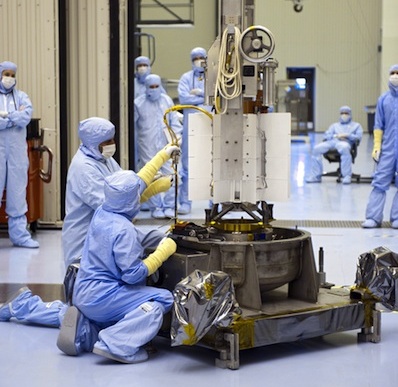This article was produced by JansenP for the Young Astronomers
NASA has just launched the Mars Science Laboratory (MSL) from the Kennedy Space Center, in the United States. The new rover, a car-sized robot known as Curiosity, is designed to wander around the Gale Crater, on Mars to determine if the area has – or had – the environmental conditions required to support life.
It’s scientific payload is composed of 10 instruments, and each depends on electric power to operate. The energy solution adopted by rovers until now – like Spirit and Opportunity – was to catch the energy of sunlight through solar arrays. The MSL in contrast, doesn’t have solar panels to take advantage of this energy. Instead, it has a system that converts the natural heat from the decay of a radioactive material into the electricity needed to operate the rover’s instruments, robotic arm, wheels, computers and radio.
Clik here to view.

An Artist's conception of Curiosity on Mars Credit: NASA/JPL-Caltech
Transforming Heat into Electricity
Clik here to view.

A pellet of Plutonium-238. It glows due the energy released by its radioactive decay Credit: U.S. Department of Energy
The power system, the -Multi-Missions Radioisotope Thermoelectric Generator (MMRTG), is basically a nuclear battery that transforms the heat given off by a radioactive isotope (or radioisotope) source into electricity to power the probe. The heat source chosen was a 4.8 kilogram (10.6 pounds) pellet of plutonium-238 dioxide (238PuO2). This system is intend to generate about 110 watts of electrical power for at least 14 years – the MSL mission is expected to last two years, but this deadline may be extended.
Radioactive isotopes can be used as fuel because they have a very interesting propriety: due their instability, the nuclei of these isotopes (an isotope is a variation of an element i.e. – atoms of the same chemical element, but with different masses) can spontaneously “break”, turning the atom into a different element– this process is called radioactive decay. During the process, the atom release energy in form of heat that can be used by a thermoelectric generator to produce electric power.
To make this thermoelectric conversion, the generator uses a physical process known as Seebeck effect, discovered by the German physicist Thomas Seebeck. It consists of two plates, each made of a different metal. Joining these two plates to form a closed electrical circuit and keeping the two junctions at different temperatures produces an electric current. These pairs of junctions are called thermocouples.
To create this temperature difference, one of the plates is heated by the radioisotope’s decay, while the other one remains unheated and cooled by the environment.
The MMRTG also charges two lithium-ion batteries. They can be used when the rover’s energy demand temporarily exceeds the steady output level of the generator, this may occur depending on the activity the rover is performing.
Reliable Energy Anytime, Anywhere
The MMRTG is a new generation of radioisotope generators, very similar to others already present in several space missions, such as Galileo, Cassini, Voyager, New Horizons, Pioneer, Ulysses, Viking and even the manned Apollo missions to the moon. However, the MMRTG is designed to operate both on planetary bodies with an atmosphere – like Mars – and in the vacuum of the space. Moreover, on the MSL the temperature control system will use the waste heat from the radioactive decay to warm a fluid that will be pumped throughout the rover to keep the electronic components within their operating temperature range.
Clik here to view.

The Mars Science Laboratory's MMRTG, before being installed Credit: NASA/Kim Shiflett
Compared to the solar power alternative studied by MLS’ designers, the MMRTG proves to be lighter and smaller, providing a significantly better mobility and flexibility to the rover’s operations. Furthermore, as the system doesn’t depend on sunlight, it can deliver energy to the robot at anytime, even during the long Martain nights.
Though the implementation of radioactive material as a fuel requires special care. Hence, the MMRTG was built with several layers of protective material designed to contain the plutonium-238 in case of a wide range of potential accidents, such as impacts or problems during a launch. Fortunately, the type of plutonium present in the radioisotope power system is different from the material used in nuclear weapons and could never explode like a bomb.
The use of these nuclear batteries have expanded the frontiers of space exploration. Thanks to radioisotope generators, we were able to visit other worlds and send missions beyond the limits of the Sun’s influence, they have enabled achievements that would otherwise not be possible. Now, this revolutionary system will allow us to go even further and explore the mystery of life on Mars.